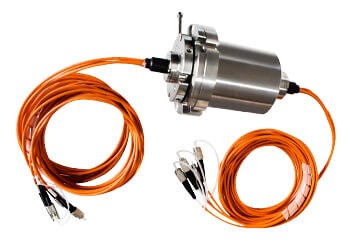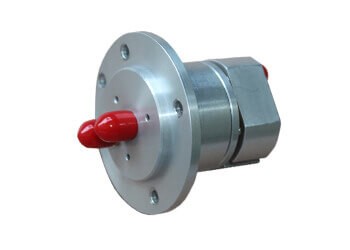Difference Between the FORJ and RF Rotary Joints
Fiber optic rotary joints (FORJs) are used to transmit high-speed data signals over optical fibers in systems that require continuous rotation. FORJs allows optical signals to be transmitted between stationary and rotating parts of a system, without any signal loss or degradation. The FORJ typically consists of a stationary component, a rotating component, and a fiber optic assembly that allows the transmission of light through the rotating joint.
RF rotary joints are used to transmit high-frequency electrical signals between stationary and rotating parts of a system. RF rotary joints allow the transmission of electromagnetic energy through a rotating joint, without signal loss or interference. RF rotary joints typically consist of two or more conductive rings that rotate with the system, allowing electrical signals to be transmitted through the joint.
Fiber Optic Rotary Joints & RF Rotary Joints
Both FORJ and RF rotary joints are devices that transmit signals through a rotary interface, which is useful in a variety of applications such as surveillance systems, military equipment, and industrial automation. Their specific application will depend on the system requirements for signal speed, frequency and accuracy.

FORJ and RF Rotary Unions Features
- Low Insertion Loss: FORJ and RF rotary joints are designed to minimize signal loss during transmission, ensuring high-quality signals and reliable performance.
- Compact size: FORJ and RF rotary unions are typically small and lightweight for use in applications where space is limited.
- Low maintenance: FORJ and RF rotary unions are designed for long-term, maintenance-free operation, with sealed housings that protect internal components from dust, moisture, and other environmental elements.
- High reliability: FORJ and RF rotary joints are designed to operate under extreme conditions, such as high temperature, high humidity and high vibration, and are highly resistant to wear and tear.
- Multi-channel: FORJ and RF rotary joints can be configured to support multi-channel, allowing multiple signals to be transmitted simultaneously.
FORJ and RF Rotary Unions are highly specialized devices designed to provide reliable and continuous signal transmission to rotary joints in a variety of industrial, military and scientific applications.
Frequently Asked Questions
Do You Offer Multi-channel Fiber Optic Rotary Joint?
Yes. We offer both multi-channel and single FORJs.
What is Good for High Speed Serial Digital Signal Rotating Transmission?
High frequency/coaxial/waveguide rotary joints are good for high speed serial digital signal and analog signal rotating transmission.
Do Your FORJs Can Combined with Electrical Slip Rings?
Yes. We have solid plans for this situation, please ask us for the demo.
What the Singlemode Type Insertion Loss Will Be?
The insertion loss will be 0.5-1.0 dB under 1,310-1,550 nm wavelengths.
What is the Maximum Data Transfer Rate Supported by FORJs?
The maximum data transfer rate supported by FORJs depends on the specific device, but it can range from a few kilobits per second up to several gigabits per second.
Can FORJs Transfer Power As Well As Data?
Yes, some FORJs can transfer both power and data across a rotating interface, allowing for the transmission of electrical power to rotating components, such as motors or sensors.
What Are the Main Factors That Affect FORJ Performance?
The main factors that affect FORJ performance include insertion loss, return loss, bandwidth, polarization sensitivity, and temperature range.
Can RF Rotary Joints Be Customized for Specific Applications?
Yes, RF rotary joints can be customized for specific applications, such as high-speed data transfer, high-frequency ranges, and multiple channels.
What Factors Should Be Considered when Selecting an RF Rotary Joint?
Factors to consider when selecting an RF rotary joint include frequency range, VSWR, insertion loss, temperature range, size, and the number of channels.
What Are the Main Types of RF Rotary Joints?
The main types of RF rotary joints include coaxial, waveguide, and fiber optic.
What is the Difference Between a Single-channel and Multi-channel RF Rotary Joint?
A single-channel RF rotary joint can only transfer one RF signal at a time, while a multi-channel RF rotary joint can transfer multiple RF signals simultaneously.
Can RF Rotary Joints Be Integrated with Other Rotary Components?
Yes, RF rotary joints can be integrated with other rotary components, such as slip rings, shafts, and bearings, to provide a complete rotary solution.
Contact Our Team
Rotary Joints: Classification, Installation and Maintenance
The two categories of Rotary Joints are fiber optic rotary joints and RF rotary joints, so what is the use of rotary joints? How to install and maintain the rotary joint?
Try clicking the following article to learn about fiber optic swivel joints, how does a fiber optic swivel joint work? What is a radio frequency rotary joint and how does a coaxial rotary joint work?



